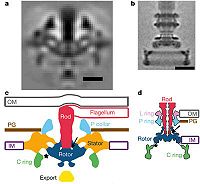Redesign the Feedback Control System of a Bacteria: Difference between revisions
No edit summary |
No edit summary |
||
| Line 6: | Line 6: | ||
Scientists are able to genetically modify microbiological organisms so that they produce certain chemicals or change their behavior. Can we redesign the control systems in bacteria (including implementation!) so that we can program their behaviors in response to external stimuli? Possible applications include new types of medical treatments, new methods for environmental remediation, and ''in vivo'' sensing systems. Initial demonstrations have demonstrated the ability to modify the sensing system, but true reprogramming would include systematic methods for designing the control system to have designed closed loop properties, including stability, performance and robustness. | Scientists are able to genetically modify microbiological organisms so that they produce certain chemicals or change their behavior. Can we redesign the control systems in bacteria (including implementation!) so that we can program their behaviors in response to external stimuli? Possible applications include new types of medical treatments, new methods for environmental remediation, and ''in vivo'' sensing systems. Initial demonstrations have demonstrated the ability to modify the sensing system, but true reprogramming would include systematic methods for designing the control system to have designed closed loop properties, including stability, performance and robustness. | ||
| | | | ||
<center> | |||
[[Image:chemotaxis-sourjik.png|400px]] | [[Image:chemotaxis-sourjik.png|400px]] | ||
[[Image:chemotaxis-pkt08.jpg|300px]] | [[Image:chemotaxis-pkt08.jpg|300px]] | ||
</center> | |||
|} | |} | ||
Revision as of 19:18, 3 June 2010
|
Chemotaxis is the process by which bacteria and other micro-organisms sense chemical signal in the environment and adjust their motion to either move toward the signal (chemoattractants) or away from the signal (chemorepellants). The chemotaxis system in E. coli consists of a sensing system that detects the presence of nutrients, an actuation system that propels the organism in its environment, and control circuitry that determines how the cell should move in the presence of chemicals that stimulate the sensing system. Each of these subsystems is implemented via proteins inside the cell, with communication, computation and control intermingled through the various molecular reactions that occur. Many chemotaxis mechanisms are stochastic in nature, with biased random motions causing the average behavior to be either positive, negative or neutral (in the absence of stimuli). Scientists are able to genetically modify microbiological organisms so that they produce certain chemicals or change their behavior. Can we redesign the control systems in bacteria (including implementation!) so that we can program their behaviors in response to external stimuli? Possible applications include new types of medical treatments, new methods for environmental remediation, and in vivo sensing systems. Initial demonstrations have demonstrated the ability to modify the sensing system, but true reprogramming would include systematic methods for designing the control system to have designed closed loop properties, including stability, performance and robustness. |
|
Context
"Systems biology" and "synthetic biology" are two major growth areas within biology. For these efforts to be successful in the long run, it will be necessary to build up a systems engineering framework for biological circuit design. Recent successes in building synthetic circuits that provide novel biological function (such as an oscillator or a programmable switch) demonstrate that the basic technology is at hand. However, initial attempts to systemize synthetic biology have not yet succeeded in building working systems from libraries of standard parts. The challenge lies in exploiting the modulator of molecular biology while at the same time building enough understanding of the fundamental processes to understand key issues in building larger and larger systems from individual components.

The components that implement chemotaxis are becoming increasingly well understood. For example, flagellar motors have been imaged in detail (figure, right), showing the incredible structure present in these systems. The basic control circuitry consists of a membrane-bound proteins for sensing chemical signals (ligands) external to the cell, signal transduction pathways that communicate the presence or absence of ligands, and feedback regulation mechanisms that modify the sensitivity of the sensor and act as a form of integral feedback. The effect of this sensing and control system is to modulate the flagella such that they spin either clockwise or counter-clockwise, resulting in either tumbling or non-tumbling motion. Dynamical models have been developed that describe the various processes that are present in chemotaxis and give insight into the system-level properties.
Design Specification and Properties
Design a control circuit that can be inserted into a bacterium and that will modify its behavior so that the bacterium can be be used to deliver a drug to a specific area in an organism. The specific condition that the bacterium responds to should be more substantially more specific than current drug treatments, targetting a very localized location in the body or an organ, for example. The drugs that are released can either be synthesized within the bacterium or stored in some inert form and released at an appropriate time and location.
Rather than just experimenting with existing cellular organisms and genetic mutations to attempt the task, the circuitry used to accomplish this task should be designed, in the usual engineering sense. This includes developing a model that predicts the behavior of the control circuit in the system and can be used to iterate on the design before synthesizing the DNA that encodes the circuit. Current technology already allows simple biological circuits to be built and inserted into bacterium, and there have been many demonstrations of genetic engineering to modify the behavior of existing systems. The goal in this grand challenge is to move from a culture of experimentation and invention, to one of systematic modeling, analysis and design.
And There's Much More
Bacterial chemotaxis is just one of many interesting processes implemented using biomolecular feedback systems.

